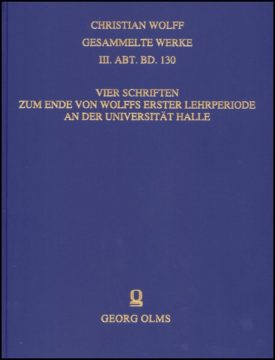Als Christian Wolff durch königliches Reskript vom 8. November 1723 seines Lehramtes enthoben und ihm „bey Strafe des Stranges“ geboten wurde, Preußen binnen 48 Stunden zu verlassen, endete jählings eine Periode gespannter, aber friedlicher Koexistenz von pietistischer Theologie und „neuer Philosophie“ an der Universität Halle. Seinerzeit dominierten einseitig gefärbte Darstellungen der Ereignisse die öffentliche Meinungsbildung, insbesondere natürlich die Streitschriften der Hauptkontrahenten Wolff und Lange.
Das Bild, das die hier versammelten anonymen bzw. pseudonymen Schriften von der Causa Wolffiana zeichnen, ist nicht nur facettenreicher, es reicht auch weit über eine Darstellung der Gründe hinaus, die zu Wolffs Vertreibung aus Halle geführt hatten. Obschon anonyme Pamphlete nie als unverdächtige Quellen gelten können, lässt sich aus ihrer Kombination mit dem überlieferten Quellenbestand und sicher verbürgten Publikationen ein erheblicher Gewinn ziehen. Die vorliegenden Schriften dokumentieren in hervorragender Weise, was das zeitgenössische Publikum von den Vorgängen in Halle wusste oder zumindest wissen konnte, wenn es sich nicht mit den Pamphleten der beiden Parteien bescheiden wollte, und fügen der Schwarz-Weiß-Malerei der unmittelbar am Streit Beteiligten wichtige Nuancen hinzu.
***
When Christian Wolff was removed from his teaching post by royal decree on 8 November 1723 and asked to leave Prussia within 48 hours “on pain of death”, a period of tense but peaceful coexistence between Pietistic theology and “new philosophy” at the University of Halle came to an abrupt end. Contemporary accounts of the events are almost all coloured by their bias towards one side or the other, especially of course the polemics by the two principal opponents, Wolff and Lange.
The picture conveyed in the anonymous or pseudonymous works about the “Causa Wolffiana” collected here is not only more nuanced but also goes far beyond a mere description of the reasons for Wolff’s expulsion from Halle. Although anonymous pamphlets can never be considered completely reliable sources, combining these with other source material and securely authenticated publications offers a considerable gain. The works provide outstanding documentation of what the contemporary public knew of events in Halle, or at least what they could know if they were not content with the pamphlets issued by the two sides, and they add subtler shades to the black-and-white depictions of events by those directly involved.
- Veröffentlicht am Mittwoch 20. November 2024 von Olms, Georg
- ISBN: 9783487143217
- 200 Seiten
- Genre: Aufklärung, Hardcover, Philosophie, Renaissance, Softcover
